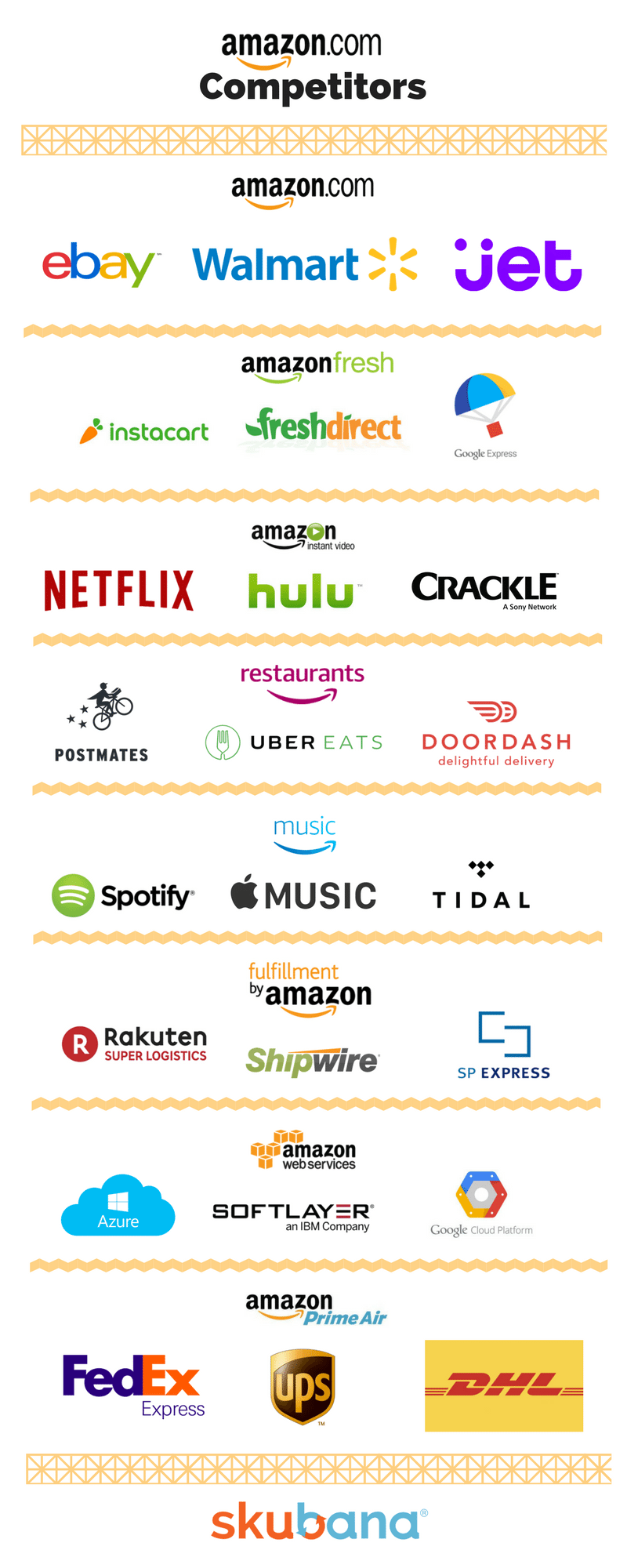E-commerce revolutionized the way we shop. It put an end to hunting through stores for batteries, or figuring out how to secure a new couch to a small car. One company in particular set the gold standard for business-to-customer interaction in this new frontier.
What started off as an online bookstore in 1995 grew to dominate the e-commerce space. Consumers love Amazon. Its customer-centric policy, convenient deliveries, large selection and low prices keep them coming back for more. And, while sellers have a more complex relationship with the marketplace it lowered the entry barrier by giving them access to a large customer base.

Back in the dark days of shopping before e-commerce, another company was the first to embrace the low price and customer first approach. Thirty years before Amazon.com became a reality, Sam Walton grew Walmart on the premise that customers needed a convenient one stop location for all their needs, that combined cheap prices with excellent service. As people moved out of the city centers and into the suburbs, giant Walmart stores gave them the convenience they craved.
While the two behemoths shared a similar founding approach, their e-commerce growth stories are quite different. Amazon grew organically over time, carefully building their audience, onboarding sellers and developing new products and services. Walmart, on the other hand, is growing it's e-commerce empire through rapid acquisition. And while selling on Walmart vs. Amazon is similar, there are some key differences.
A look at Amazon’s organic growth
Today, there’s very little Amazon doesn’t do. They deliver fresh food to your door, stream movies and shows to your devices and build partnerships with cable giants HBO, Showtime and STARZ so you can cut that cord. Amazon Kindle Unlimited has a monthly book subscription, AWS runs a huge part of the internet, CloudFront is a big player in the CDN market and Alexa helps around the house. They have fingers in all the pies.

Amazon has painstakingly built itself into the customer’s go to solution for everything. If you want an insight into the e-commerce giant’s approach to growth look no further than AmazonBasics. It launched in 2009 with a few cables and batteries, providing convenient and cheap solutions to unglamorous needs. This was an unthreatening foray into their own label development. Cables aren’t exactly a big money game.
But, over the next few years Amazon studied how its products performed compared to others in the basics category. It carefully analyzed the top competitor products in those categories and then created a much cheaper alternative to rise to the top. Basics was just the start. Amazon quietly developed other private label brands in different categories that can compete with third party sellers on more than just price.
Starting life as a marketplace gave Amazon access to both customers and vital selling data. It gave them the means to use strong analytics to develop lines and services the consumer needed.
The winning organic tactic

The various branches of Amazon are built on a strong interlocking foundation. Like in a Lego Wonderland, all the different pieces are a part of an interconnected network that supports each piece and urges the consumer to try another product.
Everything feeds into each other. If you are happy with the great delivery, why not try Prime? Oh, and look! We put some movie suggestions you can stream straight to your phone based on that book you bought last month. And, if you love the streaming service, why not check out the brand new Basics headphones? This is Amazon after all. If it doesn’t work out, returns are free. We’ve got your back.
Amazon painstakingly created a customer base and then worked hard on growing it by providing everything a consumer may possibly need. The marketplace expanded to support the customers and the customer base grew as a response to more products and feedback from its loyal userbase.
It’s a self-fulfilling cycle of growth. Amazon looks at the needs of their customers and then creates the products to fill them. As shoppers looked for convenient ways to order food online, Amazon jumped in with Restaurants. Driving in the vicinity of the grocery store but no time to actually shop? Use Amazon Fresh Pickup.
The chief advantage of this organic growth is that it increases Amazon’s chances of success with these new ventures, as the history of Amazon Prime shows. Amazon’s access to data means they can build a product based on real need.Their brand recognition, marketing as the one stop shop and history of diverse solutions keep them at the forefront of the consumer’s mind.
Despite the multiple benefits, the organic approach to growth isn’t all sunshine and order deliveries. It is a slower path. As Amazon competitors emerged, Amazon built customer loyalty and slowly released products. It took 4 years to move from the book-only market. Prime launched in 2005 as a shipping service and took 12 years to get to the private label stage it’s at today. AmazonFresh launched in 2007, before the market for food pick-up really existed in the US. The road to total dominion is long.
Walmart’s e-commerce explosion
Walmart grew in the physical retail space, opening large stores that stocked a bit of everything. E-commerce was an afterthought at first, but as it continued gaining a stronger share of consumer spending, they couldn’t afford to keep it on the backburner. So, Walmart began an explosive growth spurt in 2011, acquiring key talent and bringing their e-commerce capabilities up to scratch.
One of the key challenges to its online growth was the difference in technology and software between the various locations. Whereas Amazon’s assets meshed together perfectly, Walmart’s underlying online tech had to be re-built from scratch so it can play at the professional level.
This is a key challenge of artificial growth. A company that grows organically already has puzzle pieces that naturally fit well together. Fast artificial growth means that you have to go in and update key parts so they fit well as a part of the new whole.
The sheer scale of the company didn’t help. When Walmart jumped into e-commerce growth it was already a behemoth with a large global presence. This meant dealing with a divergent approach and various bureaucratic processes that slow the rate of innovation. Unlike Amazon, it didn’t have access to piles of consumer data it could leverage.
Walmart embraced the acquisition approach first by acquiring online marketplace Jet and then moving onto other strong but smaller e-commerce brands like the quiet acquisitions of Modcloth and Bonobos.
Jet gave Walmart access to powerful analytics, consumer data and Marc Lore. Modcloth and Bonobos gave them a means to reach professional millennials. While Walmart has seen a reported increase of millennial consumers, the sub-group that shop at Modcloth and Bonobos have significant spending power but avoid Walmart at all cost.
To grow this way, Walmart is using a twofold approach. They are starting with their customers, promoting their online marketplace and offering free shipping on orders over $35 as a mirror of Amazon Prime without the membership. They are using Jet to capture the segments that would flood to Amazon first by acquiring and leveraging e-commerce native brands like Bonobos and Modcloth.
The battle of the strategies

Amazon started its life on the internet and grew from there. It is the digital native, experimenting with all the tools its playground has to offer. Amazon’s customers are used to going online because that’s what they’ve always done. It filled a niche and grew from there to the point where it became a customer centric solution. In the eyes of the consumer, Amazon is more than just a shopping platform- it’s a problem solver.
Walmart is the old school competition. It’s a traditionally brick-and-mortar retailer with giant warehouses and brand perception issues. Walmart’s customers are used to their physical locations. At the start, their online store was just an extension of their physical store: a service most businesses offer these days. But, instead of staying in its comfort zone, Walmart embraced e-commerce growth by restructuring it from the ground up.
When it comes to benefits, the organic approach wins hands down. It’s an easier way to expand and it means you don’t have to redesign entire systems. The advantage of Amazon is that as an early adopter they already had everything in place for their growth. The infrastructure as well as the room for acquisition was built in from the start.
Walmart’s infrastructure was quite different. It rose at a different time and it took a while to embrace the change in shopping habits. But, if the recent growth is anything to go by, an aggressive acquisition strategy is paying off.
Amazon’s growth highlights the importance of staying on top of new technologies and shopping innovations. E-commerce is just the beginning. As we wade into the internet of things, the way we shop will continue to evolve. Smart e-commerce companies will keep the doors to organic growth open and not get caught up in their current successes.







